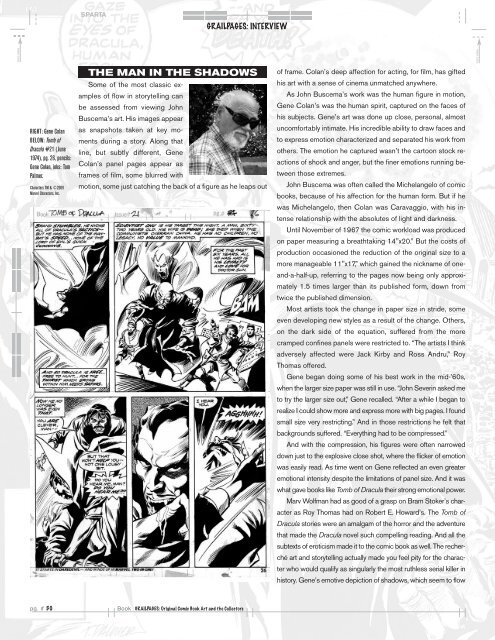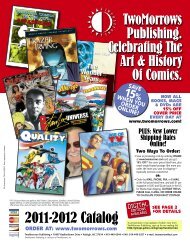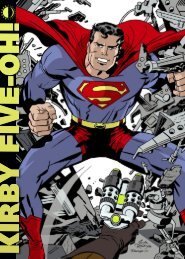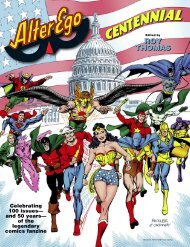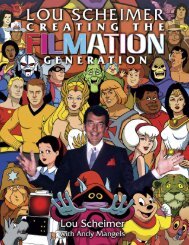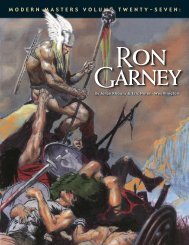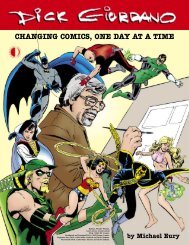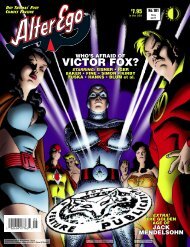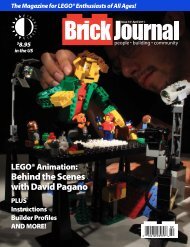Original Comic Book Art And The Collectors - TwoMorrows
Original Comic Book Art And The Collectors - TwoMorrows
Original Comic Book Art And The Collectors - TwoMorrows
You also want an ePaper? Increase the reach of your titles
YUMPU automatically turns print PDFs into web optimized ePapers that Google loves.
COPY AREA<br />
RIGHT: Gene Colan<br />
BELOW: Tomb of<br />
Dracula #21 (June<br />
1974), pg. 26, pencils:<br />
Gene Colan, inks: Tom<br />
Palmer.<br />
Characters TM & ©2009<br />
Marvel Characters, Inc.<br />
SPARTA<br />
pg. # 30 <strong>Book</strong> GRAILPAGES: <strong>Original</strong> <strong>Comic</strong> <strong>Book</strong> <strong>Art</strong> and the <strong>Collectors</strong><br />
GRAILPAGES: INTERVIEW<br />
THE MAN IN THE SHADOWS<br />
Some of the most classic ex-<br />
amples of flow in storytelling can<br />
be assessed from viewing John<br />
Buscema’s art. His images appear<br />
as snapshots taken at key moments<br />
during a story. Along that<br />
line, but subtly different, Gene<br />
Colan’s panel pages appear as<br />
frames of film, some blurred with<br />
motion, some just catching the back of a figure as he leaps out<br />
of frame. Colan’s deep affection for acting, for film, has gifted<br />
his art with a sense of cinema unmatched anywhere.<br />
As John Buscema’s work was the human figure in motion,<br />
Gene Colan’s was the human spirit, captured on the faces of<br />
his subjects. Gene’s art was done up close, personal, almost<br />
uncomfortably intimate. His incredible ability to draw faces and<br />
to express emotion characterized and separated his work from<br />
others. <strong>The</strong> emotion he captured wasn’t the cartoon stock reactions<br />
of shock and anger, but the finer emotions running between<br />
those extremes.<br />
John Buscema was often called the Michelangelo of comic<br />
books, because of his affection for the human form. But if he<br />
was Michelangelo, then Colan was Caravaggio, with his intense<br />
relationship with the absolutes of light and darkness.<br />
Until November of 1967 the comic workload was produced<br />
on paper measuring a breathtaking 14"x20.” But the costs of<br />
production occasioned the reduction of the original size to a<br />
more manageable 11"x17,” which gained the nickname of oneand-a-half-up,<br />
referring to the pages now being only approximately<br />
1.5 times larger than its published form, down from<br />
twice the published dimension.<br />
Most artists took the change in paper size in stride, some<br />
even developing new styles as a result of the change. Others,<br />
on the dark side of the equation, suffered from the more<br />
cramped confines panels were restricted to. “<strong>The</strong> artists I think<br />
adversely affected were Jack Kirby and Ross <strong>And</strong>ru,” Roy<br />
Thomas offered.<br />
Gene began doing some of his best work in the mid-’60s,<br />
when the larger size paper was still in use. “John Severin asked me<br />
to try the larger size out,” Gene recalled. “After a while I began to<br />
realize I could show more and express more with big pages. I found<br />
small size very restricting.” <strong>And</strong> in those restrictions he felt that<br />
backgrounds suffered. “Everything had to be compressed.”<br />
<strong>And</strong> with the compression, his figures were often narrowed<br />
down just to the explosive close shot, where the flicker of emotion<br />
was easily read. As time went on Gene reflected an even greater<br />
emotional intensity despite the limitations of panel size. <strong>And</strong> it was<br />
what gave books like Tomb of Dracula their strong emotional power.<br />
Marv Wolfman had as good of a grasp on Bram Stoker’s character<br />
as Roy Thomas had on Robert E. Howard’s. <strong>The</strong> Tomb of<br />
Dracula stories were an amalgam of the horror and the adventure<br />
that made the Dracula novel such compelling reading. <strong>And</strong> all the<br />
subtexts of eroticism made it to the comic book as well. <strong>The</strong> recherché<br />
art and storytelling actually made you feel pity for the character<br />
who would qualify as singularly the most ruthless serial killer in<br />
history. Gene’s emotive depiction of shadows, which seem to flow<br />
COPY AREA


